Efficiency of Single vs. Multiple Vendors in Supply Chain Management
VerifiedAdded on 2023/04/21
|29
|7633
|163
Report
AI Summary
This report delves into the debate of single versus multiple vendors in supply chain management, evaluating their impact on efficiency, quality, working capital, and inventory management. The report uses Toyota as a case study, analyzing its supply chain strategies and the advantages and disadvantages of its vendor selection. It explores the importance of supply chain management, key factors influencing it, and the application of theories like Just-in-Time and Resource-Based View. The report concludes by arguing that multiple vendors offer greater efficiency and flexibility, mitigating risks and enhancing overall performance. The report provides a comprehensive overview of supply chain management, providing an analysis of the case study and concludes by determining which vendor approach is more efficient.
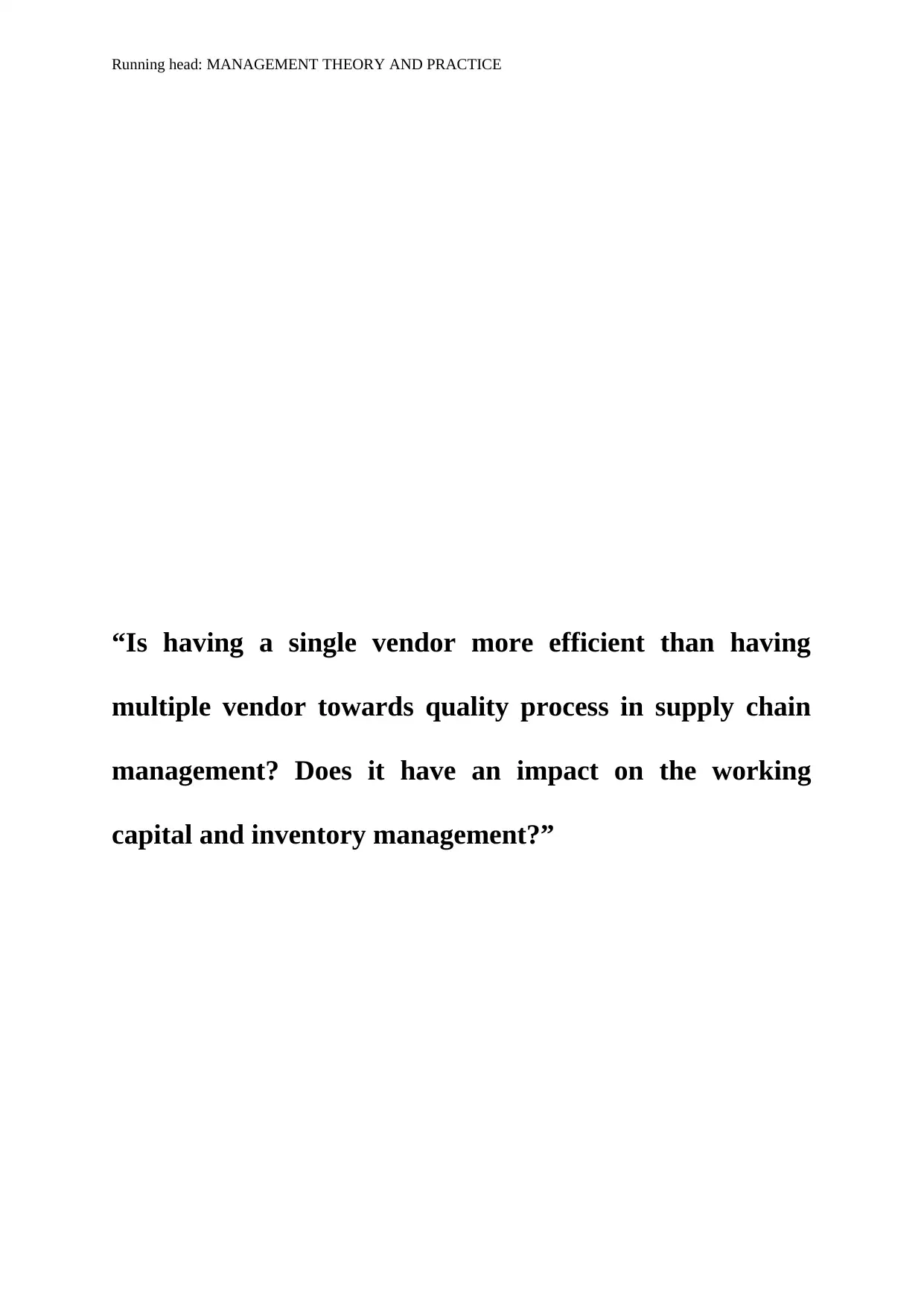
Running head: MANAGEMENT THEORY AND PRACTICE
“Is having a single vendor more efficient than having
multiple vendor towards quality process in supply chain
management? Does it have an impact on the working
capital and inventory management?”
“Is having a single vendor more efficient than having
multiple vendor towards quality process in supply chain
management? Does it have an impact on the working
capital and inventory management?”
Paraphrase This Document
Need a fresh take? Get an instant paraphrase of this document with our AI Paraphraser
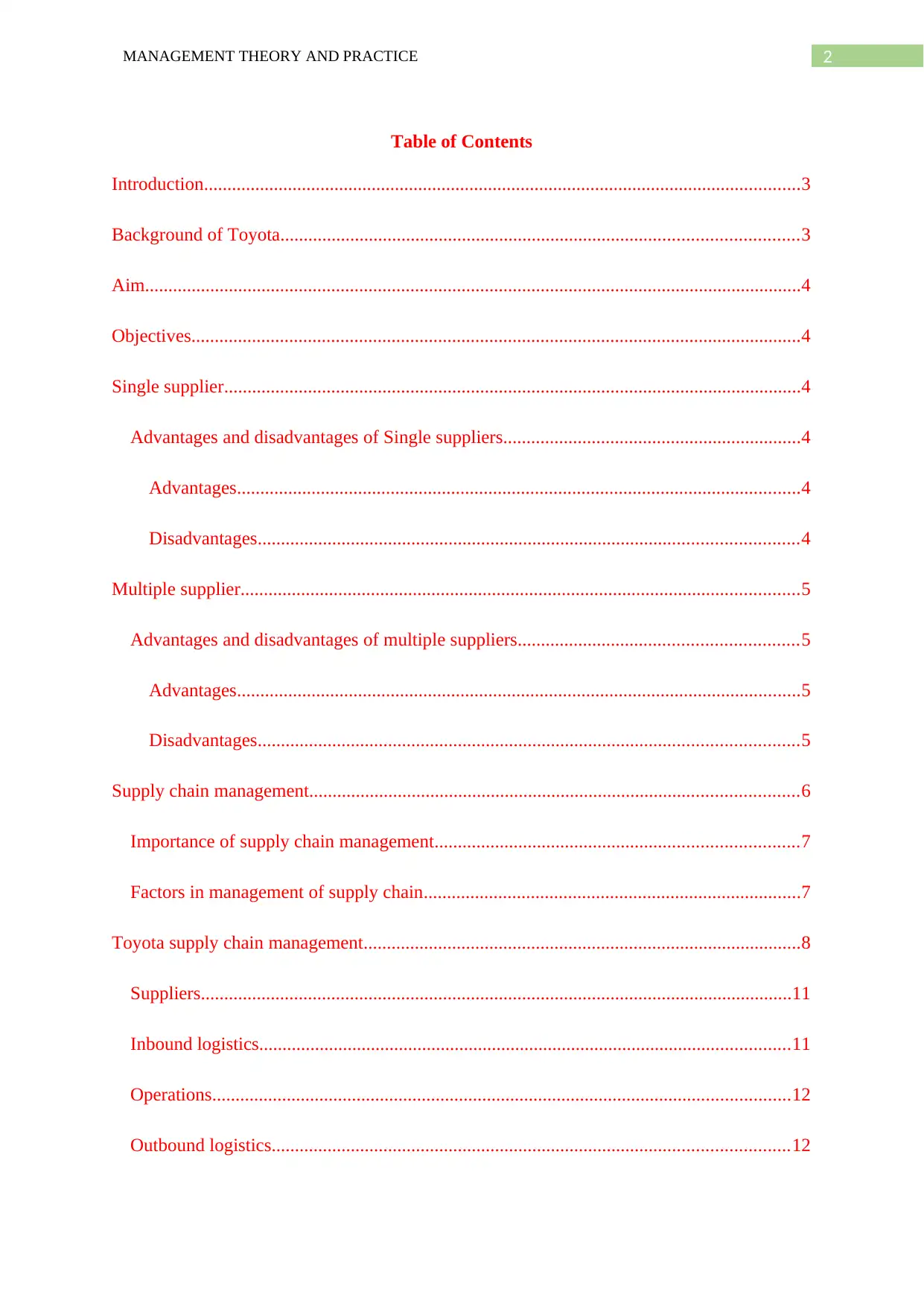
2MANAGEMENT THEORY AND PRACTICE
Table of Contents
Introduction................................................................................................................................3
Background of Toyota...............................................................................................................3
Aim.............................................................................................................................................4
Objectives...................................................................................................................................4
Single supplier............................................................................................................................4
Advantages and disadvantages of Single suppliers................................................................4
Advantages.........................................................................................................................4
Disadvantages....................................................................................................................4
Multiple supplier........................................................................................................................5
Advantages and disadvantages of multiple suppliers............................................................5
Advantages.........................................................................................................................5
Disadvantages....................................................................................................................5
Supply chain management.........................................................................................................6
Importance of supply chain management..............................................................................7
Factors in management of supply chain.................................................................................7
Toyota supply chain management..............................................................................................8
Suppliers...............................................................................................................................11
Inbound logistics..................................................................................................................11
Operations............................................................................................................................12
Outbound logistics...............................................................................................................12
Table of Contents
Introduction................................................................................................................................3
Background of Toyota...............................................................................................................3
Aim.............................................................................................................................................4
Objectives...................................................................................................................................4
Single supplier............................................................................................................................4
Advantages and disadvantages of Single suppliers................................................................4
Advantages.........................................................................................................................4
Disadvantages....................................................................................................................4
Multiple supplier........................................................................................................................5
Advantages and disadvantages of multiple suppliers............................................................5
Advantages.........................................................................................................................5
Disadvantages....................................................................................................................5
Supply chain management.........................................................................................................6
Importance of supply chain management..............................................................................7
Factors in management of supply chain.................................................................................7
Toyota supply chain management..............................................................................................8
Suppliers...............................................................................................................................11
Inbound logistics..................................................................................................................11
Operations............................................................................................................................12
Outbound logistics...............................................................................................................12
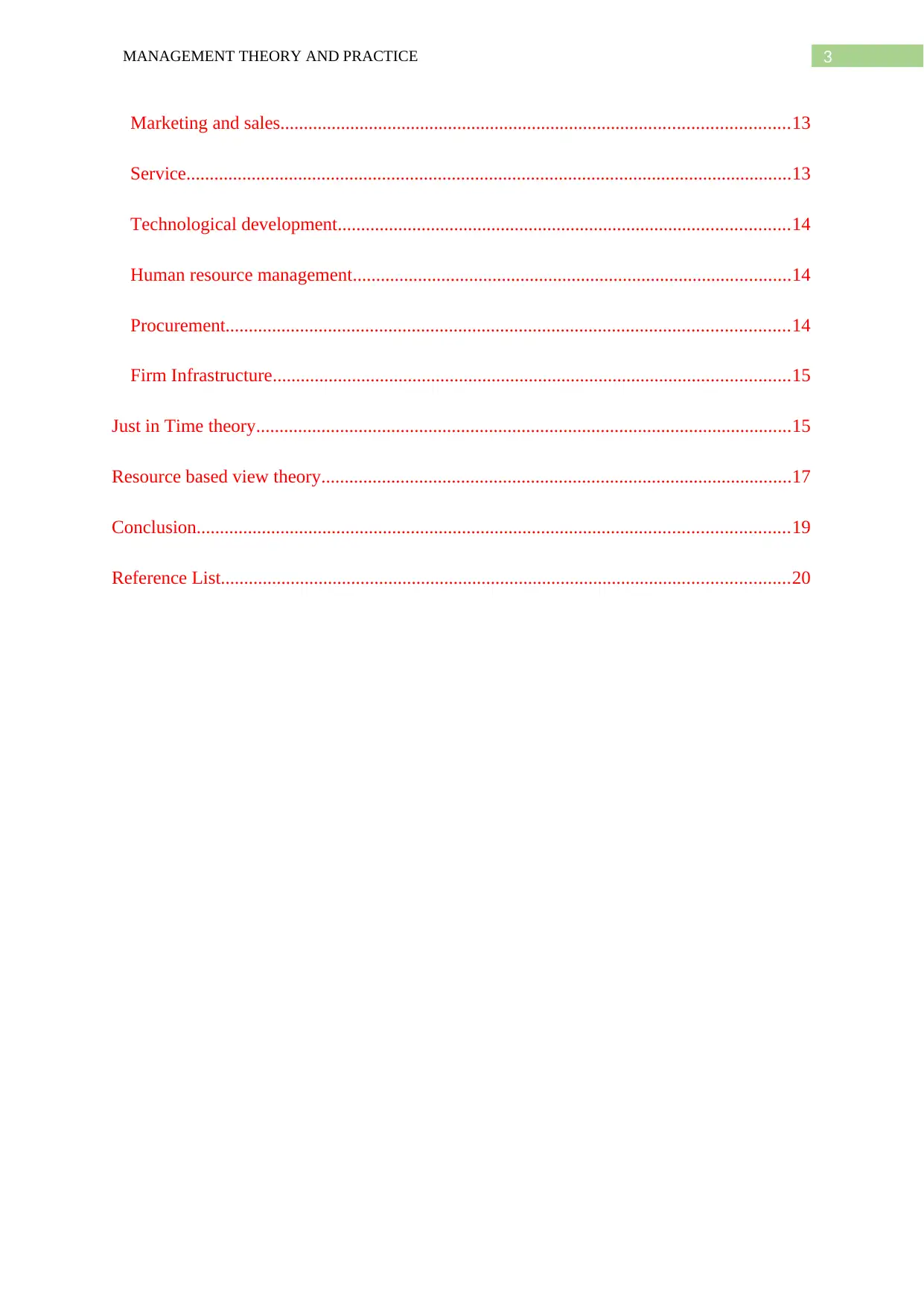
3MANAGEMENT THEORY AND PRACTICE
Marketing and sales.............................................................................................................13
Service..................................................................................................................................13
Technological development.................................................................................................14
Human resource management..............................................................................................14
Procurement.........................................................................................................................14
Firm Infrastructure...............................................................................................................15
Just in Time theory...................................................................................................................15
Resource based view theory.....................................................................................................17
Conclusion...............................................................................................................................19
Reference List..........................................................................................................................20
Marketing and sales.............................................................................................................13
Service..................................................................................................................................13
Technological development.................................................................................................14
Human resource management..............................................................................................14
Procurement.........................................................................................................................14
Firm Infrastructure...............................................................................................................15
Just in Time theory...................................................................................................................15
Resource based view theory.....................................................................................................17
Conclusion...............................................................................................................................19
Reference List..........................................................................................................................20
⊘ This is a preview!⊘
Do you want full access?
Subscribe today to unlock all pages.

Trusted by 1+ million students worldwide
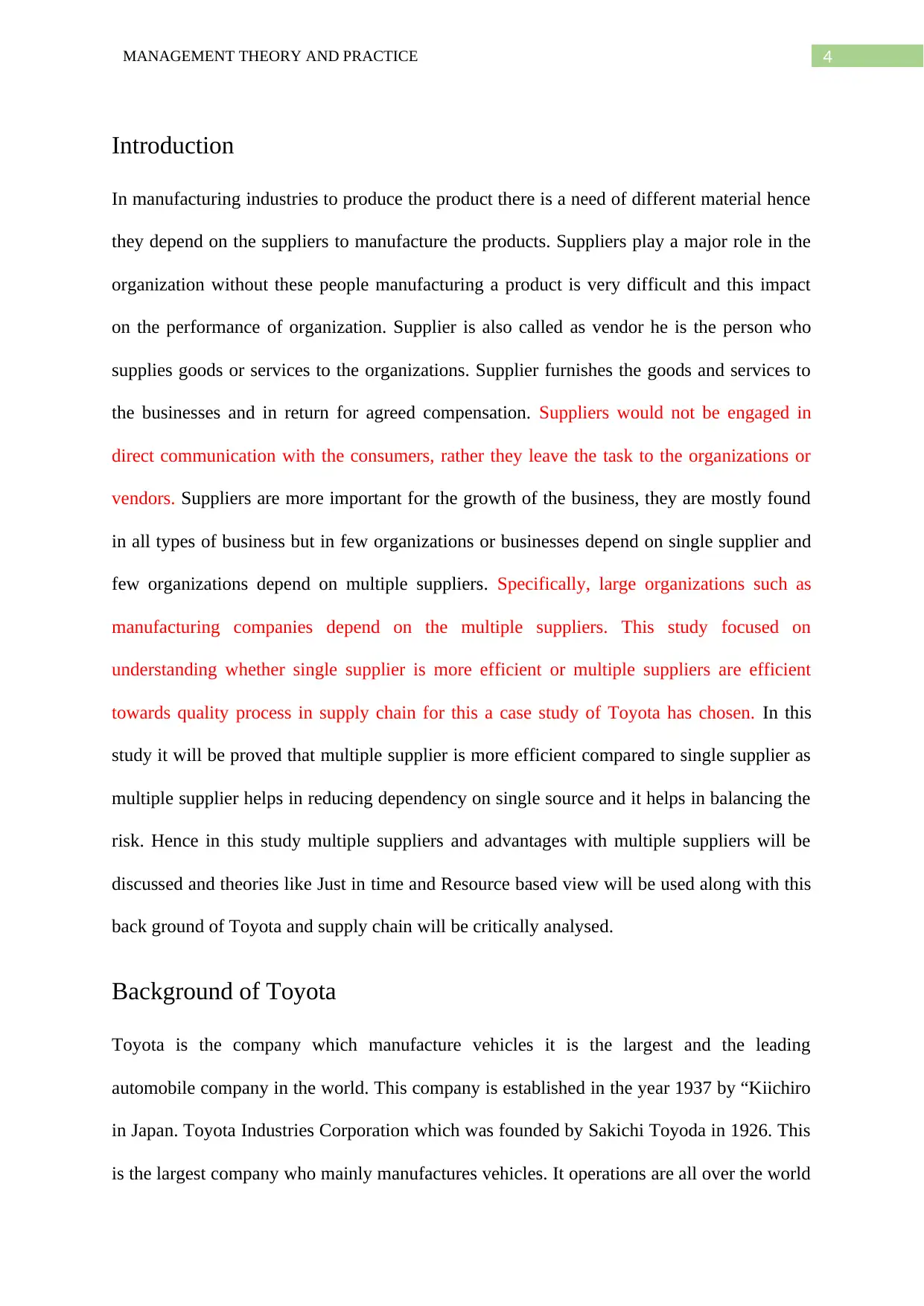
4MANAGEMENT THEORY AND PRACTICE
Introduction
In manufacturing industries to produce the product there is a need of different material hence
they depend on the suppliers to manufacture the products. Suppliers play a major role in the
organization without these people manufacturing a product is very difficult and this impact
on the performance of organization. Supplier is also called as vendor he is the person who
supplies goods or services to the organizations. Supplier furnishes the goods and services to
the businesses and in return for agreed compensation. Suppliers would not be engaged in
direct communication with the consumers, rather they leave the task to the organizations or
vendors. Suppliers are more important for the growth of the business, they are mostly found
in all types of business but in few organizations or businesses depend on single supplier and
few organizations depend on multiple suppliers. Specifically, large organizations such as
manufacturing companies depend on the multiple suppliers. This study focused on
understanding whether single supplier is more efficient or multiple suppliers are efficient
towards quality process in supply chain for this a case study of Toyota has chosen. In this
study it will be proved that multiple supplier is more efficient compared to single supplier as
multiple supplier helps in reducing dependency on single source and it helps in balancing the
risk. Hence in this study multiple suppliers and advantages with multiple suppliers will be
discussed and theories like Just in time and Resource based view will be used along with this
back ground of Toyota and supply chain will be critically analysed.
Background of Toyota
Toyota is the company which manufacture vehicles it is the largest and the leading
automobile company in the world. This company is established in the year 1937 by “Kiichiro
in Japan. Toyota Industries Corporation which was founded by Sakichi Toyoda in 1926. This
is the largest company who mainly manufactures vehicles. It operations are all over the world
Introduction
In manufacturing industries to produce the product there is a need of different material hence
they depend on the suppliers to manufacture the products. Suppliers play a major role in the
organization without these people manufacturing a product is very difficult and this impact
on the performance of organization. Supplier is also called as vendor he is the person who
supplies goods or services to the organizations. Supplier furnishes the goods and services to
the businesses and in return for agreed compensation. Suppliers would not be engaged in
direct communication with the consumers, rather they leave the task to the organizations or
vendors. Suppliers are more important for the growth of the business, they are mostly found
in all types of business but in few organizations or businesses depend on single supplier and
few organizations depend on multiple suppliers. Specifically, large organizations such as
manufacturing companies depend on the multiple suppliers. This study focused on
understanding whether single supplier is more efficient or multiple suppliers are efficient
towards quality process in supply chain for this a case study of Toyota has chosen. In this
study it will be proved that multiple supplier is more efficient compared to single supplier as
multiple supplier helps in reducing dependency on single source and it helps in balancing the
risk. Hence in this study multiple suppliers and advantages with multiple suppliers will be
discussed and theories like Just in time and Resource based view will be used along with this
back ground of Toyota and supply chain will be critically analysed.
Background of Toyota
Toyota is the company which manufacture vehicles it is the largest and the leading
automobile company in the world. This company is established in the year 1937 by “Kiichiro
in Japan. Toyota Industries Corporation which was founded by Sakichi Toyoda in 1926. This
is the largest company who mainly manufactures vehicles. It operations are all over the world
Paraphrase This Document
Need a fresh take? Get an instant paraphrase of this document with our AI Paraphraser
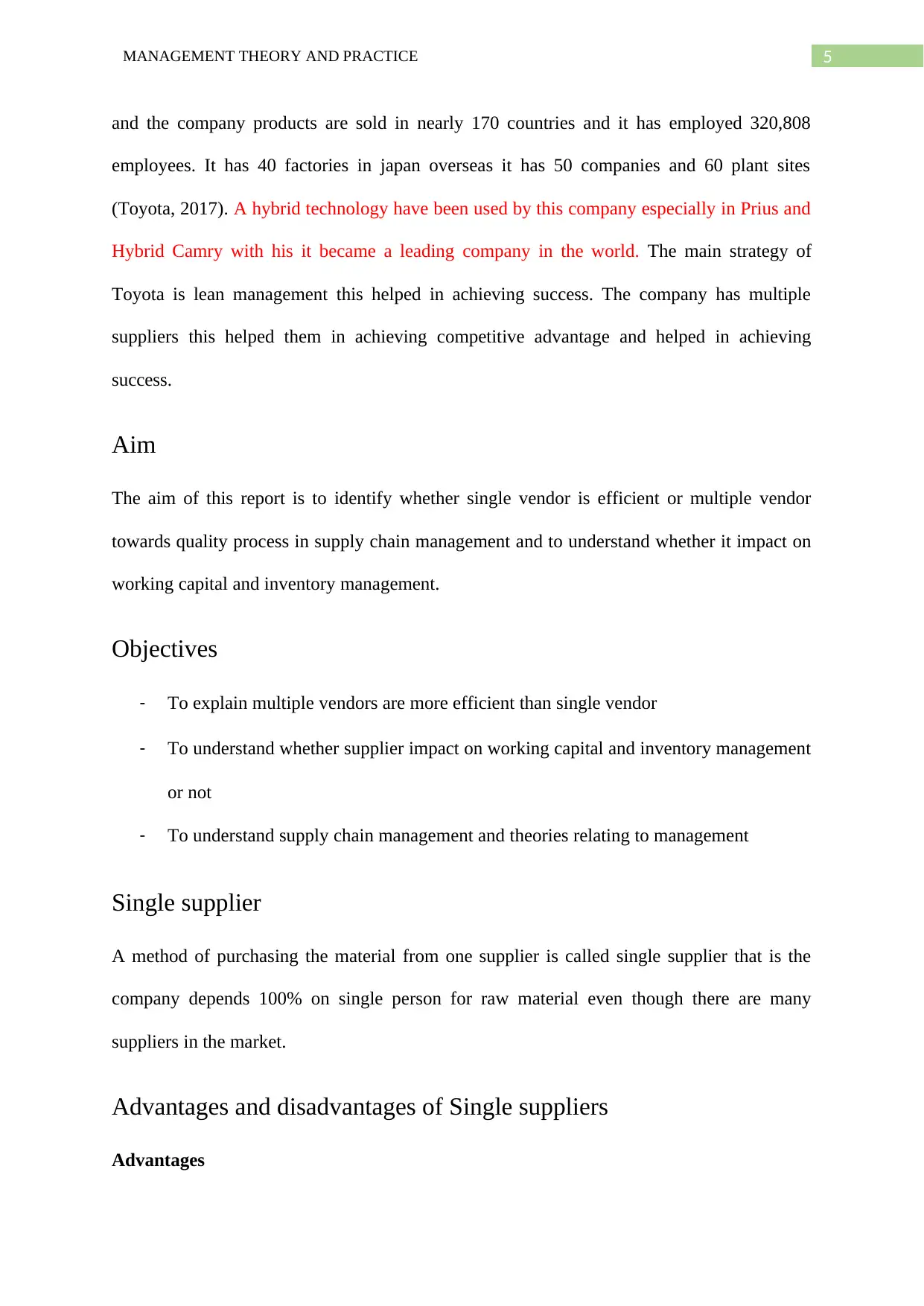
5MANAGEMENT THEORY AND PRACTICE
and the company products are sold in nearly 170 countries and it has employed 320,808
employees. It has 40 factories in japan overseas it has 50 companies and 60 plant sites
(Toyota, 2017). A hybrid technology have been used by this company especially in Prius and
Hybrid Camry with his it became a leading company in the world. The main strategy of
Toyota is lean management this helped in achieving success. The company has multiple
suppliers this helped them in achieving competitive advantage and helped in achieving
success.
Aim
The aim of this report is to identify whether single vendor is efficient or multiple vendor
towards quality process in supply chain management and to understand whether it impact on
working capital and inventory management.
Objectives
- To explain multiple vendors are more efficient than single vendor
- To understand whether supplier impact on working capital and inventory management
or not
- To understand supply chain management and theories relating to management
Single supplier
A method of purchasing the material from one supplier is called single supplier that is the
company depends 100% on single person for raw material even though there are many
suppliers in the market.
Advantages and disadvantages of Single suppliers
Advantages
and the company products are sold in nearly 170 countries and it has employed 320,808
employees. It has 40 factories in japan overseas it has 50 companies and 60 plant sites
(Toyota, 2017). A hybrid technology have been used by this company especially in Prius and
Hybrid Camry with his it became a leading company in the world. The main strategy of
Toyota is lean management this helped in achieving success. The company has multiple
suppliers this helped them in achieving competitive advantage and helped in achieving
success.
Aim
The aim of this report is to identify whether single vendor is efficient or multiple vendor
towards quality process in supply chain management and to understand whether it impact on
working capital and inventory management.
Objectives
- To explain multiple vendors are more efficient than single vendor
- To understand whether supplier impact on working capital and inventory management
or not
- To understand supply chain management and theories relating to management
Single supplier
A method of purchasing the material from one supplier is called single supplier that is the
company depends 100% on single person for raw material even though there are many
suppliers in the market.
Advantages and disadvantages of Single suppliers
Advantages
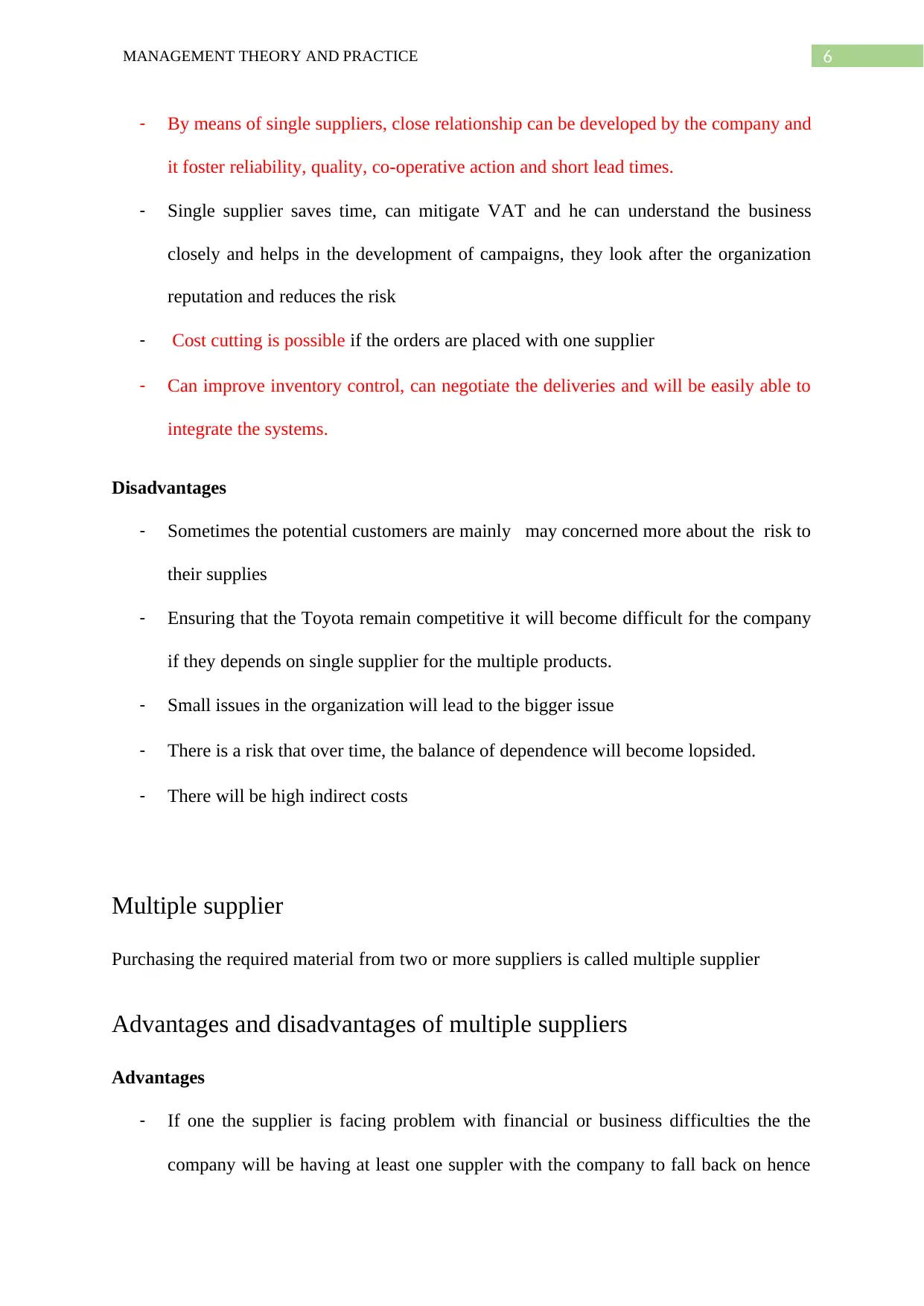
6MANAGEMENT THEORY AND PRACTICE
- By means of single suppliers, close relationship can be developed by the company and
it foster reliability, quality, co-operative action and short lead times.
- Single supplier saves time, can mitigate VAT and he can understand the business
closely and helps in the development of campaigns, they look after the organization
reputation and reduces the risk
- Cost cutting is possible if the orders are placed with one supplier
- Can improve inventory control, can negotiate the deliveries and will be easily able to
integrate the systems.
Disadvantages
- Sometimes the potential customers are mainly may concerned more about the risk to
their supplies
- Ensuring that the Toyota remain competitive it will become difficult for the company
if they depends on single supplier for the multiple products.
- Small issues in the organization will lead to the bigger issue
- There is a risk that over time, the balance of dependence will become lopsided.
- There will be high indirect costs
Multiple supplier
Purchasing the required material from two or more suppliers is called multiple supplier
Advantages and disadvantages of multiple suppliers
Advantages
- If one the supplier is facing problem with financial or business difficulties the the
company will be having at least one suppler with the company to fall back on hence
- By means of single suppliers, close relationship can be developed by the company and
it foster reliability, quality, co-operative action and short lead times.
- Single supplier saves time, can mitigate VAT and he can understand the business
closely and helps in the development of campaigns, they look after the organization
reputation and reduces the risk
- Cost cutting is possible if the orders are placed with one supplier
- Can improve inventory control, can negotiate the deliveries and will be easily able to
integrate the systems.
Disadvantages
- Sometimes the potential customers are mainly may concerned more about the risk to
their supplies
- Ensuring that the Toyota remain competitive it will become difficult for the company
if they depends on single supplier for the multiple products.
- Small issues in the organization will lead to the bigger issue
- There is a risk that over time, the balance of dependence will become lopsided.
- There will be high indirect costs
Multiple supplier
Purchasing the required material from two or more suppliers is called multiple supplier
Advantages and disadvantages of multiple suppliers
Advantages
- If one the supplier is facing problem with financial or business difficulties the the
company will be having at least one suppler with the company to fall back on hence
⊘ This is a preview!⊘
Do you want full access?
Subscribe today to unlock all pages.

Trusted by 1+ million students worldwide
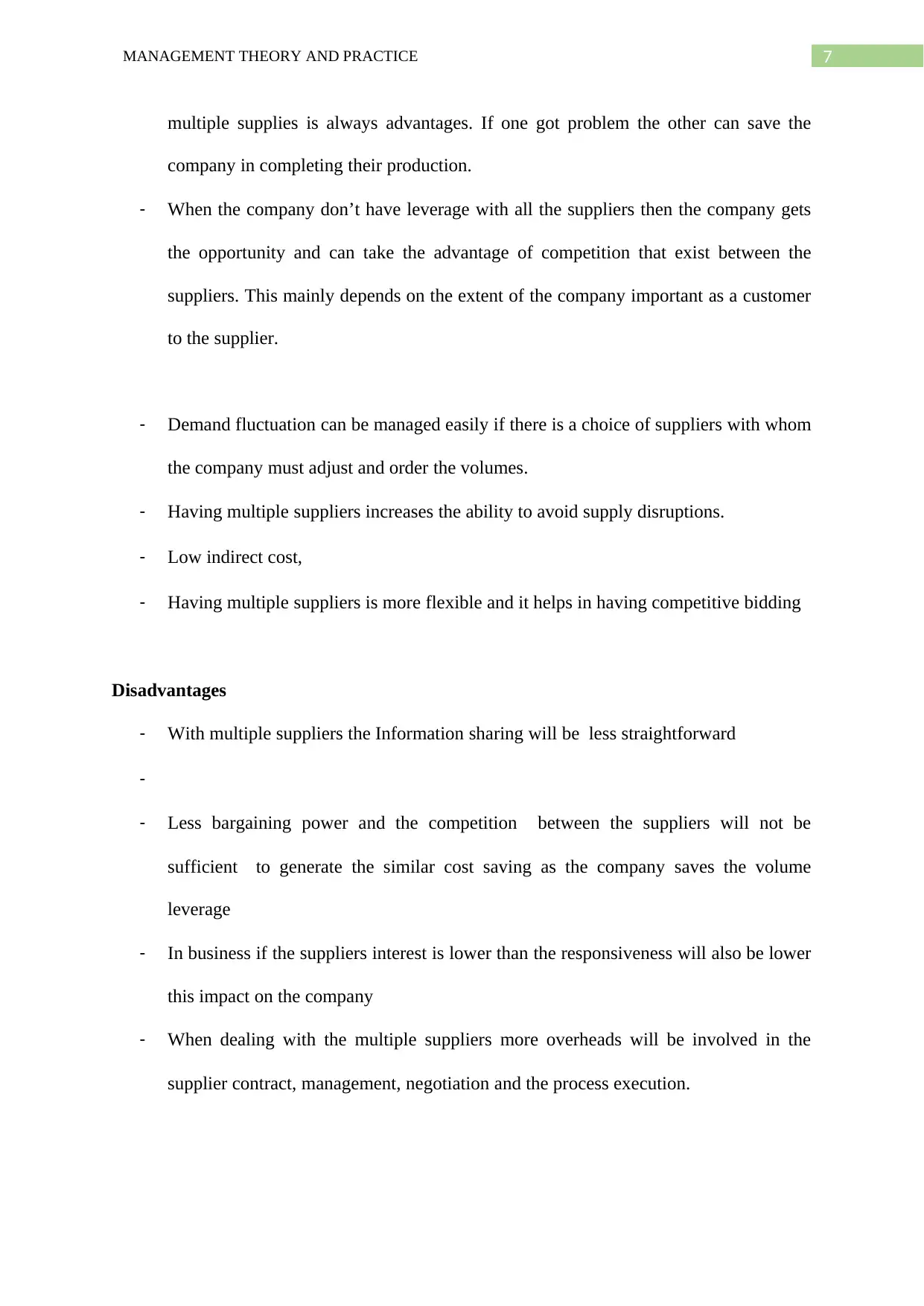
7MANAGEMENT THEORY AND PRACTICE
multiple supplies is always advantages. If one got problem the other can save the
company in completing their production.
- When the company don’t have leverage with all the suppliers then the company gets
the opportunity and can take the advantage of competition that exist between the
suppliers. This mainly depends on the extent of the company important as a customer
to the supplier.
- Demand fluctuation can be managed easily if there is a choice of suppliers with whom
the company must adjust and order the volumes.
- Having multiple suppliers increases the ability to avoid supply disruptions.
- Low indirect cost,
- Having multiple suppliers is more flexible and it helps in having competitive bidding
Disadvantages
- With multiple suppliers the Information sharing will be less straightforward
-
- Less bargaining power and the competition between the suppliers will not be
sufficient to generate the similar cost saving as the company saves the volume
leverage
- In business if the suppliers interest is lower than the responsiveness will also be lower
this impact on the company
- When dealing with the multiple suppliers more overheads will be involved in the
supplier contract, management, negotiation and the process execution.
multiple supplies is always advantages. If one got problem the other can save the
company in completing their production.
- When the company don’t have leverage with all the suppliers then the company gets
the opportunity and can take the advantage of competition that exist between the
suppliers. This mainly depends on the extent of the company important as a customer
to the supplier.
- Demand fluctuation can be managed easily if there is a choice of suppliers with whom
the company must adjust and order the volumes.
- Having multiple suppliers increases the ability to avoid supply disruptions.
- Low indirect cost,
- Having multiple suppliers is more flexible and it helps in having competitive bidding
Disadvantages
- With multiple suppliers the Information sharing will be less straightforward
-
- Less bargaining power and the competition between the suppliers will not be
sufficient to generate the similar cost saving as the company saves the volume
leverage
- In business if the suppliers interest is lower than the responsiveness will also be lower
this impact on the company
- When dealing with the multiple suppliers more overheads will be involved in the
supplier contract, management, negotiation and the process execution.
Paraphrase This Document
Need a fresh take? Get an instant paraphrase of this document with our AI Paraphraser
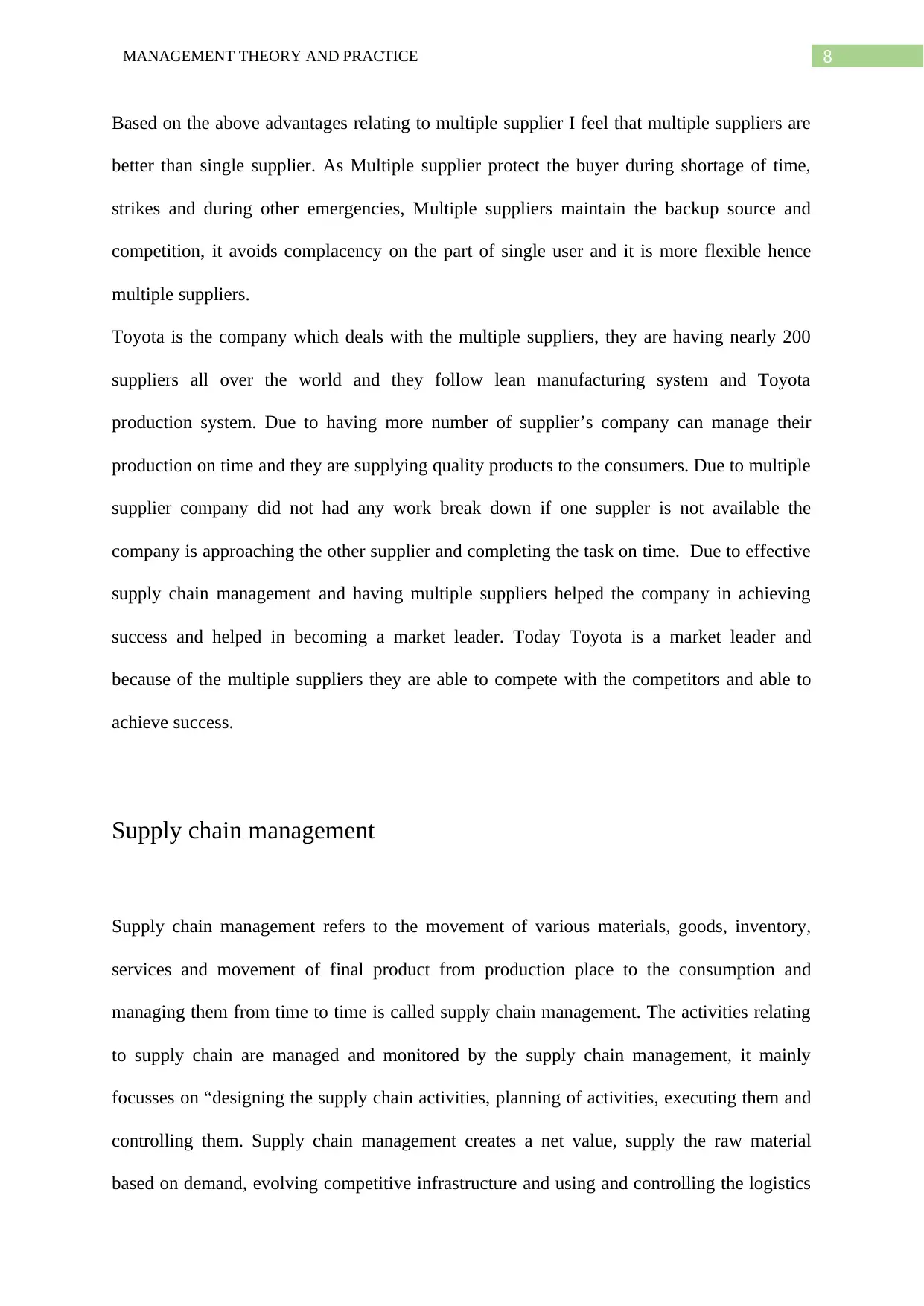
8MANAGEMENT THEORY AND PRACTICE
Based on the above advantages relating to multiple supplier I feel that multiple suppliers are
better than single supplier. As Multiple supplier protect the buyer during shortage of time,
strikes and during other emergencies, Multiple suppliers maintain the backup source and
competition, it avoids complacency on the part of single user and it is more flexible hence
multiple suppliers.
Toyota is the company which deals with the multiple suppliers, they are having nearly 200
suppliers all over the world and they follow lean manufacturing system and Toyota
production system. Due to having more number of supplier’s company can manage their
production on time and they are supplying quality products to the consumers. Due to multiple
supplier company did not had any work break down if one suppler is not available the
company is approaching the other supplier and completing the task on time. Due to effective
supply chain management and having multiple suppliers helped the company in achieving
success and helped in becoming a market leader. Today Toyota is a market leader and
because of the multiple suppliers they are able to compete with the competitors and able to
achieve success.
Supply chain management
Supply chain management refers to the movement of various materials, goods, inventory,
services and movement of final product from production place to the consumption and
managing them from time to time is called supply chain management. The activities relating
to supply chain are managed and monitored by the supply chain management, it mainly
focusses on “designing the supply chain activities, planning of activities, executing them and
controlling them. Supply chain management creates a net value, supply the raw material
based on demand, evolving competitive infrastructure and using and controlling the logistics
Based on the above advantages relating to multiple supplier I feel that multiple suppliers are
better than single supplier. As Multiple supplier protect the buyer during shortage of time,
strikes and during other emergencies, Multiple suppliers maintain the backup source and
competition, it avoids complacency on the part of single user and it is more flexible hence
multiple suppliers.
Toyota is the company which deals with the multiple suppliers, they are having nearly 200
suppliers all over the world and they follow lean manufacturing system and Toyota
production system. Due to having more number of supplier’s company can manage their
production on time and they are supplying quality products to the consumers. Due to multiple
supplier company did not had any work break down if one suppler is not available the
company is approaching the other supplier and completing the task on time. Due to effective
supply chain management and having multiple suppliers helped the company in achieving
success and helped in becoming a market leader. Today Toyota is a market leader and
because of the multiple suppliers they are able to compete with the competitors and able to
achieve success.
Supply chain management
Supply chain management refers to the movement of various materials, goods, inventory,
services and movement of final product from production place to the consumption and
managing them from time to time is called supply chain management. The activities relating
to supply chain are managed and monitored by the supply chain management, it mainly
focusses on “designing the supply chain activities, planning of activities, executing them and
controlling them. Supply chain management creates a net value, supply the raw material
based on demand, evolving competitive infrastructure and using and controlling the logistics
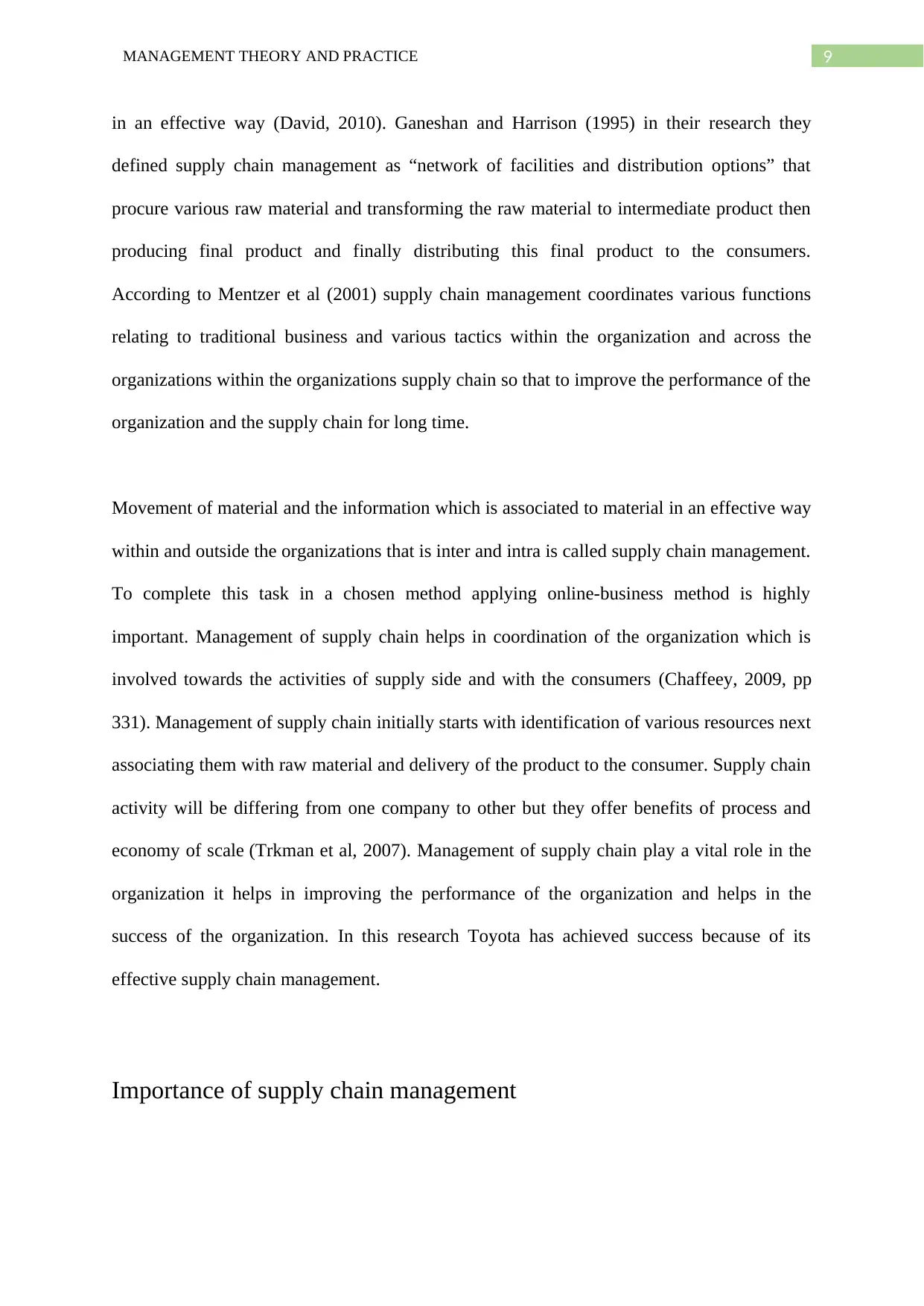
9MANAGEMENT THEORY AND PRACTICE
in an effective way (David, 2010). Ganeshan and Harrison (1995) in their research they
defined supply chain management as “network of facilities and distribution options” that
procure various raw material and transforming the raw material to intermediate product then
producing final product and finally distributing this final product to the consumers.
According to Mentzer et al (2001) supply chain management coordinates various functions
relating to traditional business and various tactics within the organization and across the
organizations within the organizations supply chain so that to improve the performance of the
organization and the supply chain for long time.
Movement of material and the information which is associated to material in an effective way
within and outside the organizations that is inter and intra is called supply chain management.
To complete this task in a chosen method applying online-business method is highly
important. Management of supply chain helps in coordination of the organization which is
involved towards the activities of supply side and with the consumers (Chaffeey, 2009, pp
331). Management of supply chain initially starts with identification of various resources next
associating them with raw material and delivery of the product to the consumer. Supply chain
activity will be differing from one company to other but they offer benefits of process and
economy of scale (Trkman et al, 2007). Management of supply chain play a vital role in the
organization it helps in improving the performance of the organization and helps in the
success of the organization. In this research Toyota has achieved success because of its
effective supply chain management.
Importance of supply chain management
in an effective way (David, 2010). Ganeshan and Harrison (1995) in their research they
defined supply chain management as “network of facilities and distribution options” that
procure various raw material and transforming the raw material to intermediate product then
producing final product and finally distributing this final product to the consumers.
According to Mentzer et al (2001) supply chain management coordinates various functions
relating to traditional business and various tactics within the organization and across the
organizations within the organizations supply chain so that to improve the performance of the
organization and the supply chain for long time.
Movement of material and the information which is associated to material in an effective way
within and outside the organizations that is inter and intra is called supply chain management.
To complete this task in a chosen method applying online-business method is highly
important. Management of supply chain helps in coordination of the organization which is
involved towards the activities of supply side and with the consumers (Chaffeey, 2009, pp
331). Management of supply chain initially starts with identification of various resources next
associating them with raw material and delivery of the product to the consumer. Supply chain
activity will be differing from one company to other but they offer benefits of process and
economy of scale (Trkman et al, 2007). Management of supply chain play a vital role in the
organization it helps in improving the performance of the organization and helps in the
success of the organization. In this research Toyota has achieved success because of its
effective supply chain management.
Importance of supply chain management
⊘ This is a preview!⊘
Do you want full access?
Subscribe today to unlock all pages.

Trusted by 1+ million students worldwide
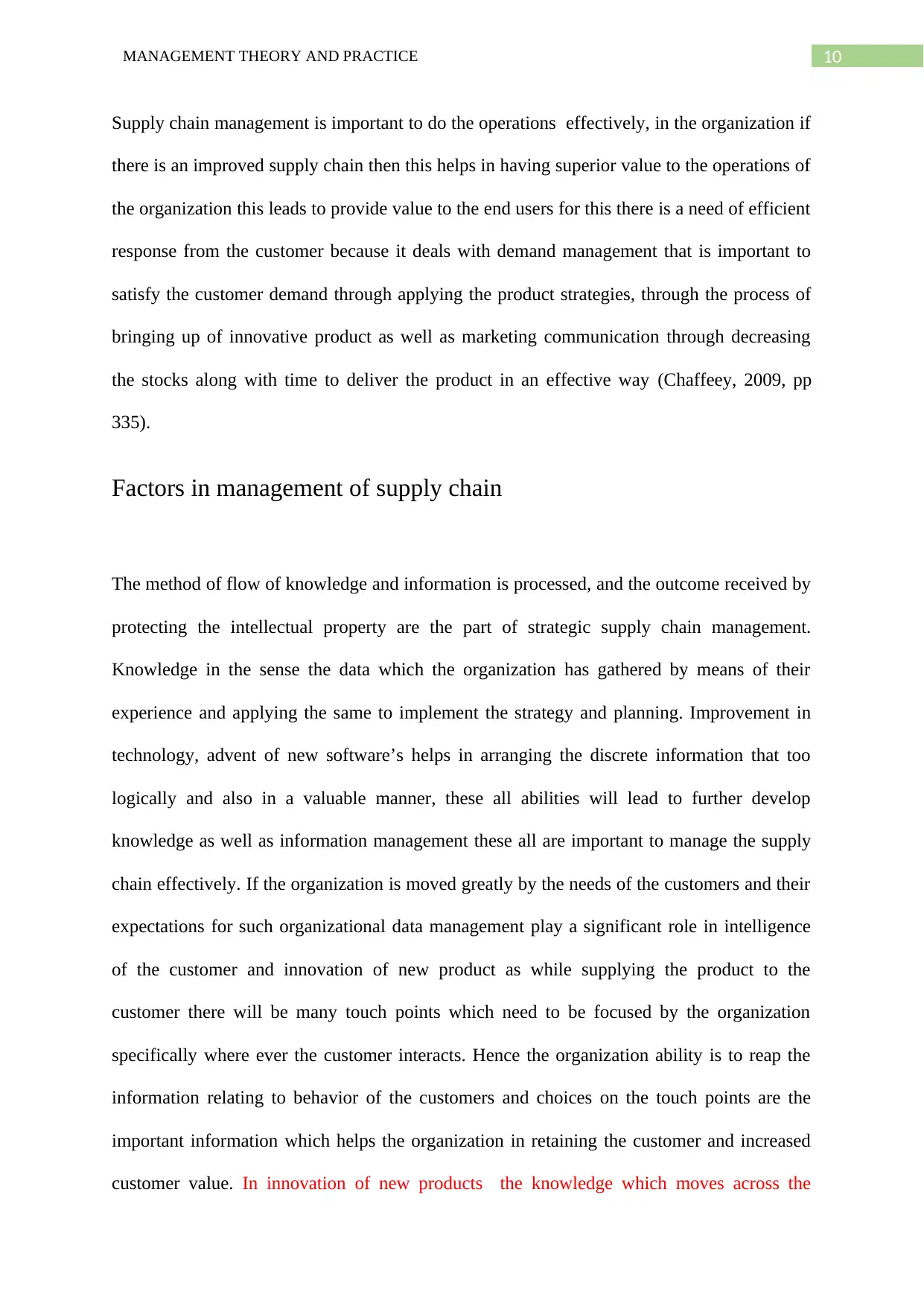
10MANAGEMENT THEORY AND PRACTICE
Supply chain management is important to do the operations effectively, in the organization if
there is an improved supply chain then this helps in having superior value to the operations of
the organization this leads to provide value to the end users for this there is a need of efficient
response from the customer because it deals with demand management that is important to
satisfy the customer demand through applying the product strategies, through the process of
bringing up of innovative product as well as marketing communication through decreasing
the stocks along with time to deliver the product in an effective way (Chaffeey, 2009, pp
335).
Factors in management of supply chain
The method of flow of knowledge and information is processed, and the outcome received by
protecting the intellectual property are the part of strategic supply chain management.
Knowledge in the sense the data which the organization has gathered by means of their
experience and applying the same to implement the strategy and planning. Improvement in
technology, advent of new software’s helps in arranging the discrete information that too
logically and also in a valuable manner, these all abilities will lead to further develop
knowledge as well as information management these all are important to manage the supply
chain effectively. If the organization is moved greatly by the needs of the customers and their
expectations for such organizational data management play a significant role in intelligence
of the customer and innovation of new product as while supplying the product to the
customer there will be many touch points which need to be focused by the organization
specifically where ever the customer interacts. Hence the organization ability is to reap the
information relating to behavior of the customers and choices on the touch points are the
important information which helps the organization in retaining the customer and increased
customer value. In innovation of new products the knowledge which moves across the
Supply chain management is important to do the operations effectively, in the organization if
there is an improved supply chain then this helps in having superior value to the operations of
the organization this leads to provide value to the end users for this there is a need of efficient
response from the customer because it deals with demand management that is important to
satisfy the customer demand through applying the product strategies, through the process of
bringing up of innovative product as well as marketing communication through decreasing
the stocks along with time to deliver the product in an effective way (Chaffeey, 2009, pp
335).
Factors in management of supply chain
The method of flow of knowledge and information is processed, and the outcome received by
protecting the intellectual property are the part of strategic supply chain management.
Knowledge in the sense the data which the organization has gathered by means of their
experience and applying the same to implement the strategy and planning. Improvement in
technology, advent of new software’s helps in arranging the discrete information that too
logically and also in a valuable manner, these all abilities will lead to further develop
knowledge as well as information management these all are important to manage the supply
chain effectively. If the organization is moved greatly by the needs of the customers and their
expectations for such organizational data management play a significant role in intelligence
of the customer and innovation of new product as while supplying the product to the
customer there will be many touch points which need to be focused by the organization
specifically where ever the customer interacts. Hence the organization ability is to reap the
information relating to behavior of the customers and choices on the touch points are the
important information which helps the organization in retaining the customer and increased
customer value. In innovation of new products the knowledge which moves across the
Paraphrase This Document
Need a fresh take? Get an instant paraphrase of this document with our AI Paraphraser
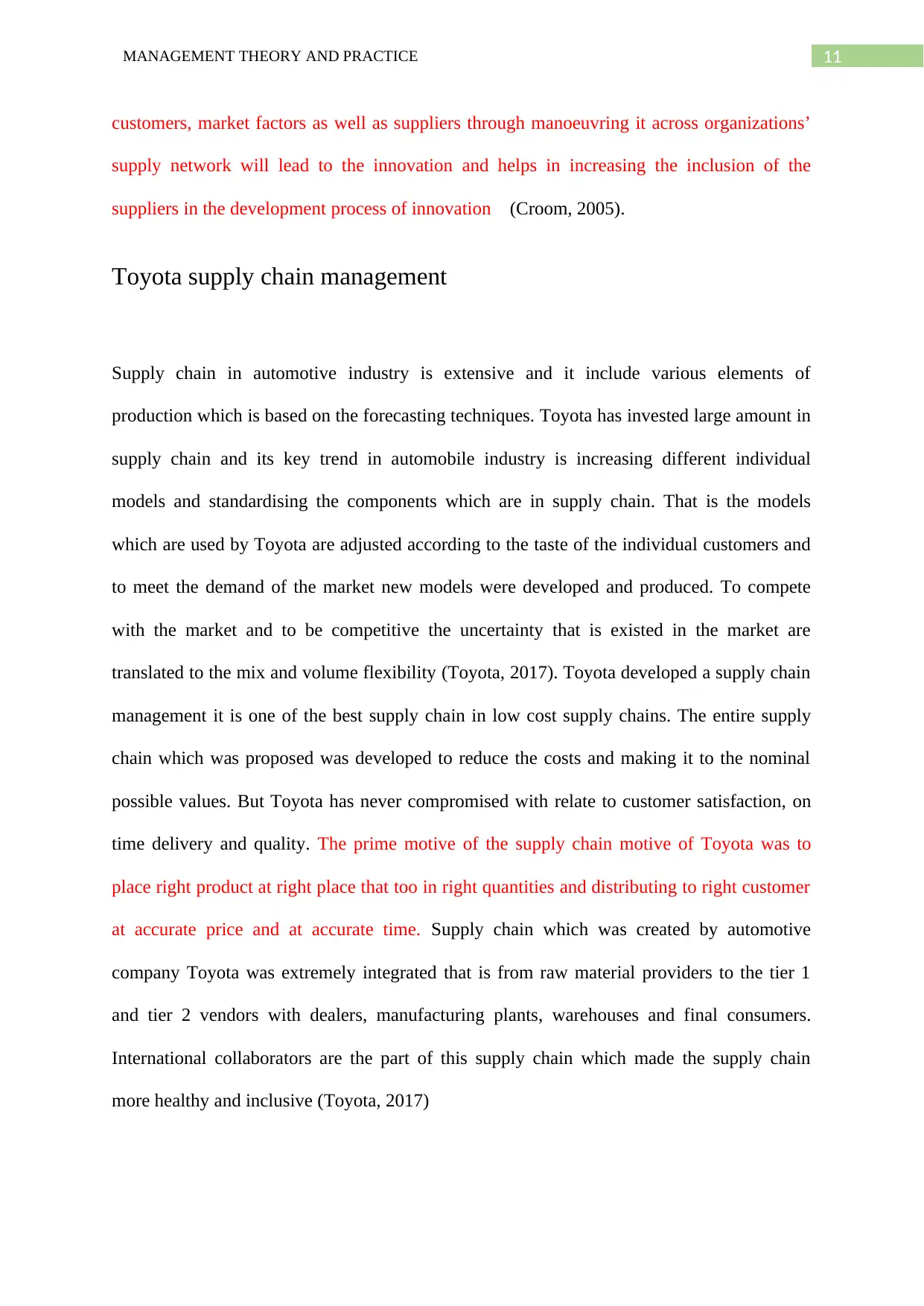
11MANAGEMENT THEORY AND PRACTICE
customers, market factors as well as suppliers through manoeuvring it across organizations’
supply network will lead to the innovation and helps in increasing the inclusion of the
suppliers in the development process of innovation (Croom, 2005).
Toyota supply chain management
Supply chain in automotive industry is extensive and it include various elements of
production which is based on the forecasting techniques. Toyota has invested large amount in
supply chain and its key trend in automobile industry is increasing different individual
models and standardising the components which are in supply chain. That is the models
which are used by Toyota are adjusted according to the taste of the individual customers and
to meet the demand of the market new models were developed and produced. To compete
with the market and to be competitive the uncertainty that is existed in the market are
translated to the mix and volume flexibility (Toyota, 2017). Toyota developed a supply chain
management it is one of the best supply chain in low cost supply chains. The entire supply
chain which was proposed was developed to reduce the costs and making it to the nominal
possible values. But Toyota has never compromised with relate to customer satisfaction, on
time delivery and quality. The prime motive of the supply chain motive of Toyota was to
place right product at right place that too in right quantities and distributing to right customer
at accurate price and at accurate time. Supply chain which was created by automotive
company Toyota was extremely integrated that is from raw material providers to the tier 1
and tier 2 vendors with dealers, manufacturing plants, warehouses and final consumers.
International collaborators are the part of this supply chain which made the supply chain
more healthy and inclusive (Toyota, 2017)
customers, market factors as well as suppliers through manoeuvring it across organizations’
supply network will lead to the innovation and helps in increasing the inclusion of the
suppliers in the development process of innovation (Croom, 2005).
Toyota supply chain management
Supply chain in automotive industry is extensive and it include various elements of
production which is based on the forecasting techniques. Toyota has invested large amount in
supply chain and its key trend in automobile industry is increasing different individual
models and standardising the components which are in supply chain. That is the models
which are used by Toyota are adjusted according to the taste of the individual customers and
to meet the demand of the market new models were developed and produced. To compete
with the market and to be competitive the uncertainty that is existed in the market are
translated to the mix and volume flexibility (Toyota, 2017). Toyota developed a supply chain
management it is one of the best supply chain in low cost supply chains. The entire supply
chain which was proposed was developed to reduce the costs and making it to the nominal
possible values. But Toyota has never compromised with relate to customer satisfaction, on
time delivery and quality. The prime motive of the supply chain motive of Toyota was to
place right product at right place that too in right quantities and distributing to right customer
at accurate price and at accurate time. Supply chain which was created by automotive
company Toyota was extremely integrated that is from raw material providers to the tier 1
and tier 2 vendors with dealers, manufacturing plants, warehouses and final consumers.
International collaborators are the part of this supply chain which made the supply chain
more healthy and inclusive (Toyota, 2017)
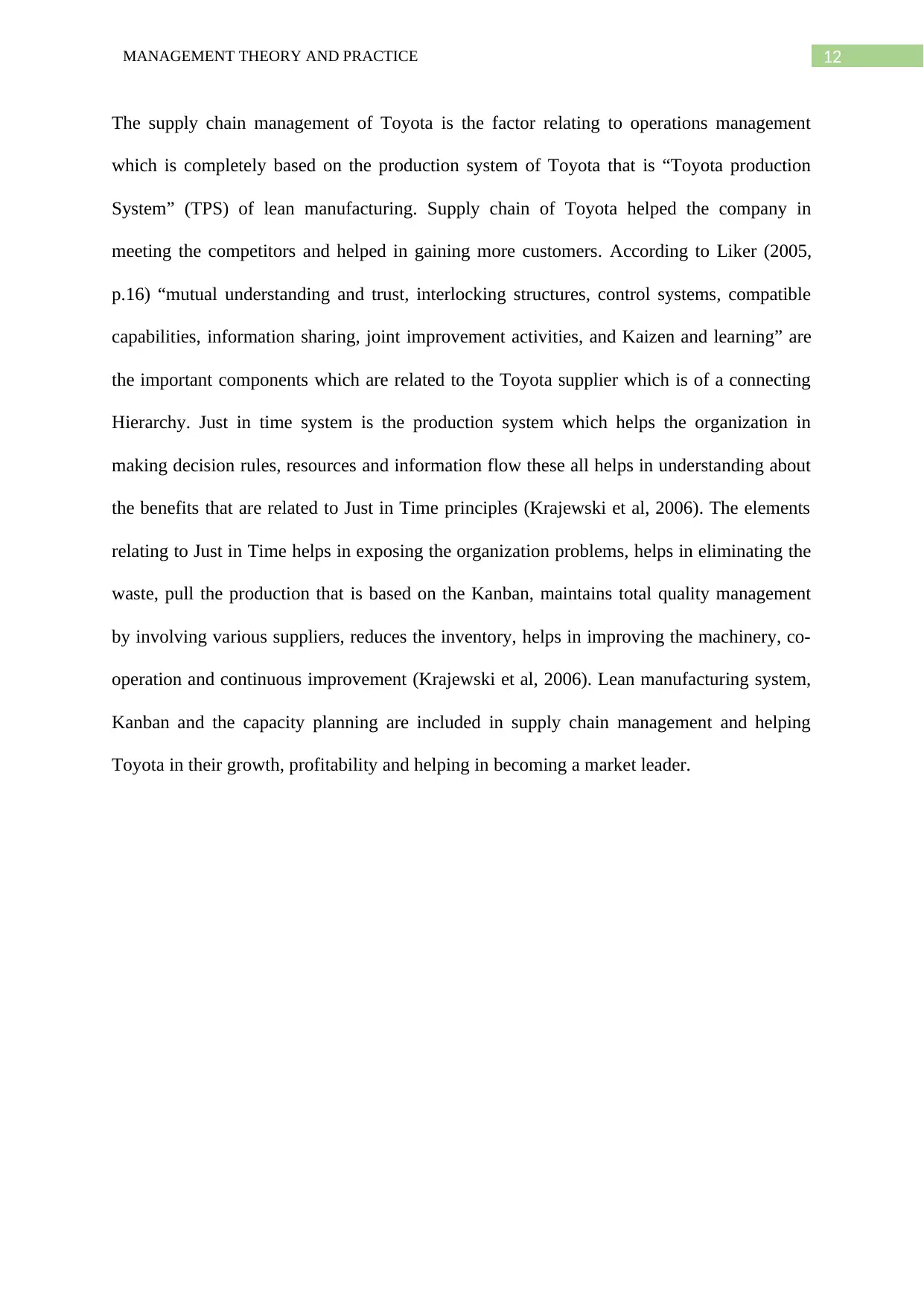
12MANAGEMENT THEORY AND PRACTICE
The supply chain management of Toyota is the factor relating to operations management
which is completely based on the production system of Toyota that is “Toyota production
System” (TPS) of lean manufacturing. Supply chain of Toyota helped the company in
meeting the competitors and helped in gaining more customers. According to Liker (2005,
p.16) “mutual understanding and trust, interlocking structures, control systems, compatible
capabilities, information sharing, joint improvement activities, and Kaizen and learning” are
the important components which are related to the Toyota supplier which is of a connecting
Hierarchy. Just in time system is the production system which helps the organization in
making decision rules, resources and information flow these all helps in understanding about
the benefits that are related to Just in Time principles (Krajewski et al, 2006). The elements
relating to Just in Time helps in exposing the organization problems, helps in eliminating the
waste, pull the production that is based on the Kanban, maintains total quality management
by involving various suppliers, reduces the inventory, helps in improving the machinery, co-
operation and continuous improvement (Krajewski et al, 2006). Lean manufacturing system,
Kanban and the capacity planning are included in supply chain management and helping
Toyota in their growth, profitability and helping in becoming a market leader.
The supply chain management of Toyota is the factor relating to operations management
which is completely based on the production system of Toyota that is “Toyota production
System” (TPS) of lean manufacturing. Supply chain of Toyota helped the company in
meeting the competitors and helped in gaining more customers. According to Liker (2005,
p.16) “mutual understanding and trust, interlocking structures, control systems, compatible
capabilities, information sharing, joint improvement activities, and Kaizen and learning” are
the important components which are related to the Toyota supplier which is of a connecting
Hierarchy. Just in time system is the production system which helps the organization in
making decision rules, resources and information flow these all helps in understanding about
the benefits that are related to Just in Time principles (Krajewski et al, 2006). The elements
relating to Just in Time helps in exposing the organization problems, helps in eliminating the
waste, pull the production that is based on the Kanban, maintains total quality management
by involving various suppliers, reduces the inventory, helps in improving the machinery, co-
operation and continuous improvement (Krajewski et al, 2006). Lean manufacturing system,
Kanban and the capacity planning are included in supply chain management and helping
Toyota in their growth, profitability and helping in becoming a market leader.
⊘ This is a preview!⊘
Do you want full access?
Subscribe today to unlock all pages.

Trusted by 1+ million students worldwide
1 out of 29
Related Documents
Your All-in-One AI-Powered Toolkit for Academic Success.
+13062052269
info@desklib.com
Available 24*7 on WhatsApp / Email
![[object Object]](/_next/static/media/star-bottom.7253800d.svg)
Unlock your academic potential
Copyright © 2020–2025 A2Z Services. All Rights Reserved. Developed and managed by ZUCOL.





